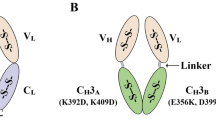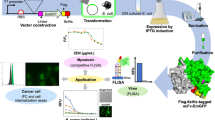Abstract
The expression of recombinant antibody fragments in the cytoplasmic space of Escherichia coli and the refolding process for restoring the structure and activity of such antibodies are not efficient. Herein, fragment antigen-binding (Fab) antibodies against miroestrol and deoxymiroestrol (MD-Fab) and their fusions with a green fluorescent protein (GFP) were expressed. The reactive MD-Fabs were successfully expressed as soluble and active forms in the cytoplasm of the SHuffle® T7 E. coli strain. Regarding the construct of MD-Fab alone, VH–CH1 could associate VL–CL into Fab in the oxidizing cytoplasm of the E. coli strain, and no additional in vitro refolding was needed. In the case of the fusions with GFP, when the C-terminus of VH–CH1 was linked with the N-terminus of GFP, the MD-Fab binding reactivity was retained, but the fluorescent activity of GFP interfered. When the C-terminus of GFP was linked to the N-terminus of VL–CL, the binding activity of MD-Fab was not observed. The constructed MD-Fabs had higher specificity toward deoxymiroestrol than the parental monoclonal antibody clone 12G11. In conclusion, MD-Fabs could be expressed using SHuffle® T7 E. coli cells. This process could be considered an economical, productive, and effective method to produce antibody fragments for immunoassay techniques.




Similar content being viewed by others
References
Frenzel A, Hust M, Schirrmann T (2013) Expression of recombinant antibodies. Front Immunol 4:217. https://doi.org/10.3389/fimmu.2013.00217
Sockolosky JT, Szoka FC (2013) Periplasmic production via the pET expression system of soluble, bioactive human growth hormone. Protein Expres Purif 87(2):129–135. https://doi.org/10.1016/j.pep.2012.11.002
Robinson MP, Ke N, Lobstein J, Peterson C, Szkodny A, Mansell TJ, Tuckey C, Riggs PD, Colussi PA, Noren CJ, Taron CH, DeLisa MP, Berkmen M (2015) Efficient expression of full-length antibodies in the cytoplasm of engineered bacteria. Nat Commun 6(1):8072. https://doi.org/10.1038/ncomms9072
Lobstein J, Emrich CA, Jeans C, Faulkner M, Riggs P, Berkmen M (2012) SHuffle, a novel Escherichia coli protein expression strain capable of correctly folding disulfide bonded proteins in its cytoplasm. Microb Cell Fact 11:56. https://doi.org/10.1186/1475-2859-11-56
Yusakul G, Kitisripanya T, Juengwatanatrakul T, Sakamoto S, Tanaka H, Putalun W (2018) Enzyme linked immunosorbent assay for total potent estrogenic miroestrol and deoxymiroestrol of Pueraria candollei, a Thai herb for menopause remedy. J Nat Med 72(3):641–650. https://doi.org/10.1007/s11418-018-1194-x
Sakamoto S, Taura F, Putalun W, Pongkitwitoon B, Tsuchihashi R, Morimoto S, Kinjo J, Shoyama Y, Tanaka H (2009) Construction and expression of specificity-improved single-chain variable fragments against the bioactive naphthoquinone, plumbagin. Biol Pharm Bull 32(3):434–439. https://doi.org/10.1248/bpb.32.434
Pongkitwitoon B, Sakamoto S, Morinaga O, Juengwatanatrakul T, Shoyama Y, Tanaka H, Morimoto S (2011) Single-chain variable fragment antibody against ginsenoside Re as an effective tool for the determination of ginsenosides in various ginsengs. J Nat Med 65(1):24–30. https://doi.org/10.1007/s11418-010-0446-1
Yusakul G, Nuntawong P, Sakamoto S, Ratnatilaka Na Bhuket P, Kohno T, Kikkawa N, Rojsitthisak P, Shimizu K, Tanaka H, Morimoto S (2017) Bacterial expression of a single-chain variable fragment (scFv) antibody against ganoderic acid A: a cost-effective approach for quantitative analysis using the scFv-based enzyme-linked immunosorbent assay. Biol Pharm Bull 40(10):1767–1774. https://doi.org/10.1248/bpb.b17-00531
Paudel MK, Sakamoto S, Van Huy L, Tanaka H, Miyamoto T, Morimoto S (2017) The effect of varying the peptide linker length in a single chain variable fragment antibody against wogonin glucuronide. J Biotechnol 251:47–52. https://doi.org/10.1016/j.jbiotec.2017.04.002
Yusakul G, Sakamoto S, Nuntawong P, Tanaka H, Morimoto S (2018) Different expression systems resulted in varied binding properties of anti-paclitaxel single-chain variable fragment antibody clone 1C2. J Nat Med 72(1):310–316. https://doi.org/10.1007/s11418-017-1136-z
Huang D, Shusta EV (2006) A yeast platform for the production of single-chain antibody-green fluorescent protein fusions. Appl Environ Microbiol 72(12):7748–7759. https://doi.org/10.1128/AEM.01403-06
Niemantsverdriet M, Backendorf C (2008) TwinGFP, a marker for cell cycle analysis in transiently transfected cells. Anal Biochem 375(2):173–178. https://doi.org/10.1016/j.ab.2008.01.015
Richards HA, Halfhill MD, Millwood RJ, Stewart CN Jr (2003) Quantitative GFP fluorescence as an indicator of recombinant protein synthesis in transgenic plants. Plant Cell Rep 22(2):117–121. https://doi.org/10.1007/s00299-003-0638-1
Jeong GM, Kim YS, Jeong KJ (2014) A human kringle domain-based fluorescence-linked immunosorbent assay system. Anal Biochem 451:63–68. https://doi.org/10.1016/j.ab.2014.01.019
Chandeying V, Lamlertkittikul S (2007) Challenges in the conduct of Thai herbal scientific study: efficacy and safety of phytoestrogen, Pueraria mirifica (Kwao Keur Kao), phase I, in the alleviation of climacteric symptoms in perimenopausal women. J Med Assoc Thai 90(7):1274–1280
Manonai J, Chittacharoen A, Theppisai U, Theppisai H (2007) Effect of Pueraria mirifica on vaginal health. Menopause 14(5):919–924. https://doi.org/10.1097/gme.0b013e3180399486
Okamura S, Sawada Y, Satoh T, Sakamoto H, Saito Y, Sumino H, Takizawa T, Kogure T, Chaichantipyuth C, Higuchi Y, Ishikawa T, Sakamaki T (2008) Pueraria mirifica phytoestrogens improve dyslipidemia in postmenopausal women probably by activating estrogen receptor subtypes. Tohoku J Exp Med 216(4):341–351. https://doi.org/10.1620/tjem.216.341
Krebber A, Bornhauser S, Burmester J, Honegger A, Willuda J, Bosshard HR, Pluckthun A (1997) Reliable cloning of functional antibody variable domains from hybridomas and spleen cell repertoires employing a reengineered phage display system. J Immunol Methods 201(1):35–55. https://doi.org/10.1016/s0022-1759(96)00208-6
Engberg J, Jensen LB, Yenidunya AF, Brandt K, Riise E (2001) Phage-display libraries of murine antibody Fab fragments. In: Kontermann R, Dübel S (eds) Antibody engineering. Springer, Berlin, pp 65–92
Kram KE, Finkel SE (2015) Rich medium composition affects Escherichia coli survival, glycation, and mutation frequency during long-term batch culture. Appl Environ Microbiol 81(13):4442–4450. https://doi.org/10.1128/AEM.00722-15
Chan CE, Lim AP, Chan AH, MacAry PA, Hanson BJ (2010) Optimized expression of full-length IgG1 antibody in a common E. coli strain. PLoS ONE 5(4):e10261. https://doi.org/10.1371/journal.pone.0010261
Krittanai S, Kitisripanya T, Udomsin O, Tanaka H, Sakamoto S, Juengwatanatrakul T, Putalun W (2018) Development of a colloidal gold nanoparticle-based immunochromatographic strip for the one-step detection of miroestrol and puerarin. Biomed Chromatogr 32(11):e4330. https://doi.org/10.1002/bmc.4330
Pongkitwitoon B, Boonsnongcheep P, Kitisripanya T, Yusakul G, Sakamoto S, Tanaka H, Morimoto S, Putalun W (2019) Preparation of a highly specific single chain variable fragment antibody targeting miroestrol and its application in quality control of Pueraria candollei by enzyme-linked immunosorbent assay. Phytochem Anal 30(6):600–608. https://doi.org/10.1002/pca.2832
Jansen EJ, van Bakel NH, Olde Loohuis NF, Hafmans TG, Arentsen T, Coenen AJ, Scheenen WJ, Martens GJ (2012) Identification of domains within the V-ATPase accessory subunit Ac45 involved in V-ATPase transport and Ca2+-dependent exocytosis. J Biol Chem 287(33):27537–27546. https://doi.org/10.1074/jbc.M112.356105
Yi KS, Chung J, Park KH, Kim K, Im SY, Choi CY, Im MJ, Kim UH (2004) Expression system for enhanced green fluorescence protein conjugated recombinant antibody fragment. Hybrid Hybridomics 23(5):279–286. https://doi.org/10.1089/hyb.2004.23.279
Yusakul G, Sakamoto S, Tanaka H, Morimoto S (2018) Improvement of heavy and light chain assembly by modification of heavy chain constant region 1 (CH1): application for the construction of an anti-paclitaxel fragment antigen-binding (Fab) antibody. J Biotechnol 288:41–47. https://doi.org/10.1016/j.jbiotec.2018.10.009
Huang Z, Li G, Zhang C, Xing XH (2016) A study on the effects of linker flexibility on acid phosphatase PhoC-GFP fusion protein using a novel linker library. Enzyme Microb Technol 83:1–6. https://doi.org/10.1016/j.enzmictec.2015.11.002
Levy R, Weiss R, Chen G, Iverson BL, Georgiou G (2001) Production of correctly folded Fab antibody fragment in the cytoplasm of Escherichia coli trxB gor mutants via the coexpression of molecular chaperones. Protein Expr Purif 23(2):338–347. https://doi.org/10.1006/prep.2001.1520
Robinson MP, Ke N, Lobstein J, Peterson C, Szkodny A, Mansell TJ, Tuckey C, Riggs PD, Colussi PA, Noren CJ, Taron CH, DeLisa MP, Berkmen M (2015) Efficient expression of full-length antibodies in the cytoplasm of engineered bacteria. Nat Commun 6:8072. https://doi.org/10.1038/ncomms9072
Sakamoto S, Pongkitwitoon B, Nakahara H, Shibata O, Shoyama Y, Tanaka H, Morimoto S (2012) Fluobodies against bioactive natural products and their application in fluorescence-linked immunosorbent assay. Antibodies 1(2):239–258
Liu H, Gaza-Bulseco G, Faldu D, Chumsae C, Sun J (2008) Heterogeneity of monoclonal antibodies. J Pharm Sci 97(7):2426–2447. https://doi.org/10.1002/jps.21180
Cacia J, Keck R, Presta LG, Frenz J (1996) Isomerization of an aspartic acid residue in the complementarity-determining regions of a recombinant antibody to human IgE: identification and effect on binding affinity. Biochemistry 35(6):1897–1903. https://doi.org/10.1021/bi951526c
Rehder DS, Chelius D, McAuley A, Dillon TM, Xiao G, Crouse-Zeineddini J, Vardanyan L, Perico N, Mukku V, Brems DN, Matsumura M, Bondarenko PV (2008) Isomerization of a single aspartyl residue of anti-epidermal growth factor receptor immunoglobulin gamma2 antibody highlights the role avidity plays in antibody activity. Biochemistry 47(8):2518–2530. https://doi.org/10.1021/bi7018223
Yan Y, Wei H, Fu Y, Jusuf S, Zeng M, Ludwig R, Krystek SR Jr, Chen G, Tao L, Das TK (2016) Isomerization and oxidation in the complementarity-determining regions of a monoclonal antibody: a study of the modification-structure-function correlations by hydrogen-deuterium exchange mass spectrometry. Anal Chem 88(4):2041–2050. https://doi.org/10.1021/acs.analchem.5b02800
Macek B, Forchhammer K, Hardouin J, Weber-Ban E, Grangeasse C, Mijakovic I (2019) Protein post-translational modifications in bacteria. Nat Rev Microbiol 17(11):651–664. https://doi.org/10.1038/s41579-019-0243-0
Acknowledgements
The authors would like to express gratitude to Dr. Chaiyo Chaichantipyuth, Faculty of Pharmaceutical Sciences, Chulalongkorn University, Thailand, for authentic standards.
Funding
This research was supported by the Faculty of Pharmaceutical Sciences, Graduate School of Khon Kaen University, Thailand (Grant Number 590H11), and the National Research Council of Thailand (NRCT). This research was partially supported by the new strategic research (P2P) project, Walailak University, Thailand.
Author information
Authors and Affiliations
Corresponding author
Ethics declarations
Conflict of interest
The authors declare they have no conflict of interest.
Research involving human participants and/or animals
There is no research involving human participants and animals.
Additional information
Publisher's Note
Springer Nature remains neutral with regard to jurisdictional claims in published maps and institutional affiliations.
Electronic supplementary material
Below is the link to the electronic supplementary material.
Rights and permissions
About this article
Cite this article
Krittanai, S., Putalun, W., Sakamoto, S. et al. Expression of actively soluble antigen-binding fragment (Fab) antibody and GFP fused Fab in the cytoplasm of the engineered Escherichia coli. Mol Biol Rep 47, 4519–4529 (2020). https://doi.org/10.1007/s11033-020-05502-7
Received:
Accepted:
Published:
Issue Date:
DOI: https://doi.org/10.1007/s11033-020-05502-7




